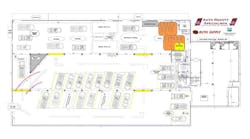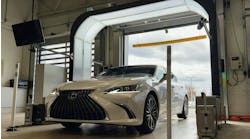What you will learn:
•To master the basics of welding
•Weld quality is not only visually appealing but is a significant for safety
•How to recognize a proper weld
Sometimes going back to the basics can make the difference between a quality repair and a failed repair. When it comes to inspecting repairs for safety and quality, one of the first things to consider are welds. This is critically important, as welds have a significant impact on the way the repair will stand the test of time—including another potential collision.
“When it comes to safety and welding, we’ll normally start with a visual inspection by checking for porosity, penetration, cleanliness, and incomplete welds,” says Scott VanHulle, I-CAR Manager, Repairability Technical Support and OEM Technical Relations. “Any of these defects will weaken the weld and may cause a repair to fail, but that is just the beginning.”
Visual Inspections and Dye Penetrant
A visual inspection is the best place to start when inspecting a weld. However, it goes beyond simply looking at a weld; you have to know what you’re seeing. While the weld may seem to be good, looks can be deceiving. Panel fit-up, flange preparation, and weld penetration are all things that can be inspected visually and give an indication of the quality of the weld.
In some cases, the vehicle maker may also call out the use of a dye penetrant that can be used to check for cracks and defects in the weld. This method is most commonly called for during aluminum welding, but this method can also be used on steel welds. Dye penetrant requires three parts: a cleaner, a dye, and a developer.
Destructive Testing of Welds
Destructively testing welds involves the physical destruction of completed practice welds in order to evaluate its characteristics, ensuring that the technician is preparing for a quality weld. This is another crucial step in the repair process and should be performed on material of similar thickness and material. This allows the person welding to accurately adjust the settings and techniques to the material and thickness that is being joined.
Destructive testing is done by tearing and twisting the test weld to show if a proper weld has been created. Why is destructively testing a weld so important? If a part were to be welded onto a vehicle without testing the welds, there is no way to know if the weld settings and techniques would create an effective weld on the vehicle. Each vehicle is so different, with so many combinations of attachment methods and material stacks, there’s no way for a welder to be set up that can effectively weld all the different scenarios that a technician may encounter on a vehicle.
Complexities of UHSS
Ultra-high-strength steel (UHSS) is still utilized and is being used in even more complex ways than in previous vehicle generations. With this level of complexity, using the proper welding techniques, attachment method, and settings becomes even more important. When spot welding is used during repairs, UHSS may not weld the same as mild steel.
The welder will need a different setting for UHSS to make a good weld. The vehicle maker may also have requirements for a specific spot-welding machine that may have preset programs for specific applications. Some spot welders may only need the sheet thickness, and the type of material to be input and the welder will make the necessary adjustments. Finally, some OEM procedures also require specific manual settings for the spot welds at specific locations to ensure the material is being joined correctly.
When GMA-welding UHSS, like boron-alloyed steel, there are additional considerations. Most UHSS parts are typically replaced using squeeze-type resistance spot welds (STRSW) at a factory seam, and GMA plug welds are used to attach the part where a spot welder cannot reach. Also, you need to understand that just because it was attached at the factory with a spot weld, it doesn’t mean that is how you’re required to replace that weld. In the vehicle specific repair manuals, procedures may include specific locations to be replaced with structural adhesives, extra welds, plug welds, structural rivets, or weld bonding. The only way to find this information is by doing the research before starting the repair to ensure that you have the correct tools and materials on hand to complete the repair.
“When making welds on UHSS to UHSS, there may not be tear-out of the weld nugget," according to Van Hulle. "When making welds on mild steel to UHSS, or high-strength low alloy (HSLA) steel to UHSS, there should be tear-out of the weld nugget of the weaker steel. If there is tear-out of the UHSS, the heat has changed the strength of the metal. First and foremost, given the many alternatives available, the initial place to turn for any welding guidelines that are vehicle-specific is the OEM repair procedures, typically found under general welding guidelines. And shop technicians are also invited to check-in to rts.i-CAR.com periodically for the most up-to-date information.”
“Ask I-CAR,” developed and managed by I-CAR’s Repairability Technical Support team, receives hundreds of calls and online submissions monthly from professionals across the country who are looking for specific collision repair resources to ensure complete, safe, and quality repairs.
Read the full article in The Safety Issue in the Collision Reporter.



